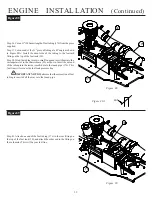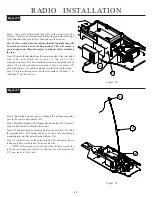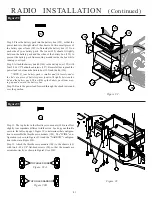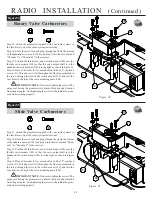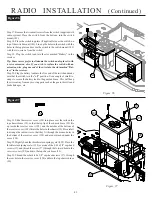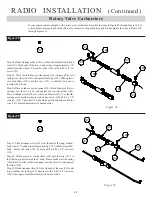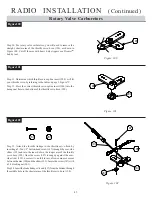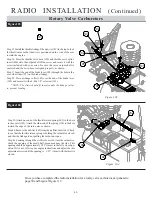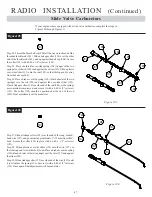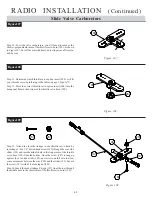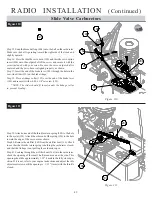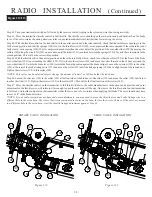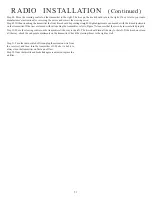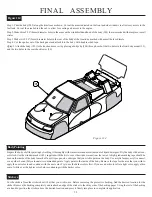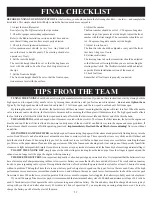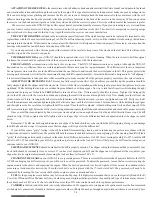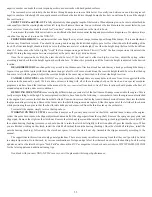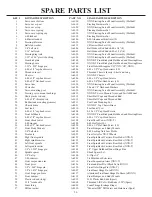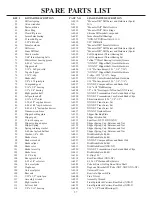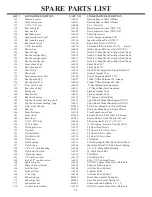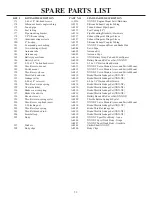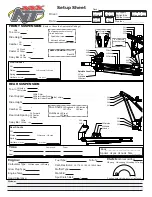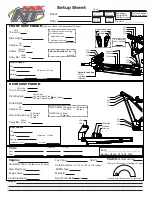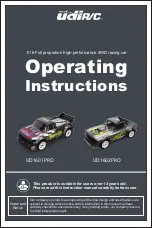
5 3
TIPS FROM THE TEAM
TUNING THE ENGINE
should be done following the manufactures instructions. If you do not have instructions, start by closing both the
high speed and low speed (idle) needle valves by turning them clockwise until you feel increased resistance –
do not over tighten them
.
Typically, the high speed needle will need to be adjusted 2 - 3 full turns open, and the low speed needle about 2 full turns open.
By turning the needle valve clockwise, the fuel mixture will become leaner – meaning that the engine will draw less fuel. When the needle
valve is turned counter-clockwise, the fuel mixture becomes richer- meaning that the engine will draw more fuel. The high speed needle affects
the fuel mixture at full throttle while the low sped needle only affects the fuel mixture at idle and the low end of the throttle band.
THE AIR FILTER
should be changed when it becomes covered with dust or dirt. The cleaner the filter remains, the better the engine can
breathe and run. If the air filter is allowed to become too dirty some of the dust or dirt can find its way into the engine and cause problems. If
the air cleaner should ever come off while operating your truck,
stop immediately. Reattach the air filter before continuing!
Never run without
an air filter.
OILING THE FOAM PRE-FILTER
can help keep dust from entering the paper air filter element and potentially finding its way into the
motor. Good filter oil can be found in most automotive sections or motorcycle shops. These specialty oils are very sticky and will attract and
hold the dust on the foam. When using this type of oil, be careful not to over oil the foam. Squeeze out any excess oil before installing the foam
pre-filter over the paper element.
Never
oil the paper element. When the foam needs cleaning wash it out using one of the specialty foam filter
cleaners or a light detergent like Simple Green. Be sure to rinse away any residual cleaner and let the foam dry before oiling and reinstalling it.
TO SHUT THE ENGINE OFF
,
simply squeeze the rubber stinger extending from the tuned pipe. Once the stinger is squeezed, and the
exhaust can no longer exit the pipe, the engine will stop running.
THE RECEIVER BATTERY
is an important, frequently overlooked part of gas-powered vehicles. It is important that the batteries always
have a fair amount of charge remaining in them. A low receiver battery can cause the truck to have a mind of its own. The result can be a runaway
truck or a poor responding radio system. If using alkaline batteries, a fresh set should operate the radio system for at least 1-2 hours of running
without a problem. The length of time that a receiver battery pack's charge lasts depends on the type of servos that are used. Some of the high
performance servos draw more current than standard servos, and will drain the receiver pack faster. Just remember to check the receiver pack
from time to time. When the servos start to operate a little slower, or radio response feels sluggish, the batteries probably need to be replaced.
If you will be using a Nicad receiver pack, it is recommended that a minimum battery size of 600 mAh and minimum voltage of 4.8 volts be
used. A Nicad battery will not operate the radio system as long as an alkaline battery. The Nicad battery should be charged before every day's
outing with your truck, and after about every 45 minutes to 1 hour of operation. If you are planning on racing a long main event, be sure to
charge the battery pack before the start of the main.
FINAL CHECKLIST
BEFORE RUNNING YOUR XXX-NT SPORT
for the first time, you should run down the following checklist — in order — and complete the
listed tasks. This simple checklist will help to make the first run much more enjoyable.
1. Adjust the rear differential
See
Adjusting The Differential
in the tips section.
2. Check for proper radio linkage adjustments
Refer to the Radio Installation section one last time and en-
sure that all linkages and collars are properly adjusted.
3. Check for free suspension movement
All suspension arms should be very free. Any binds will
cause the truck to handle poorly. The steering should also
operate very freely.
4. Set the rear ride height
The rear ride height should be set so that the dogbones are
level with the surface. See the
Rear Ride Height
section of
the tips.
5. Set the front ride height
The front ride height should be set so that the front suspen-
sion arms are level with the surface.
6. Adjust the camber
The front camber should be set to 1-1/2 degrees of negative
camber (top of tire points in) at ride height. Adjust the front
camber with the tires straight. The rear camber should be set
to 1-2 degrees of negative camber at ride height.
7. Adjust toe-in/toe-out
The front tie rods should be adjusted evenly until the front
tires have 1-degree of toe-in.
8. Set transmitter trims
The steering trim tab on the transmitter should be adjusted
so that the truck rolls straight when you are not touching the
steering wheel/stick. The throttle trim tab should be adjusted
as per the Radio Installation section of the manual.
9. Check fuel lines
Ensure that all fuel lines are properly connected.

